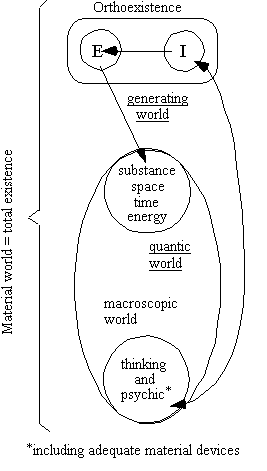But let's come back to our model. From orthoexistence
without space and time universes are born with spaces and times.
The fact that our universe may have an origin of time (t=0) is
the basis of many cosmological
theories8.
The image constructed with priority is this: "the universe
was at the beginning in a singular state, being the beginning
of time, the notion of time before this origin having no sense
at all"9.
Using the data provided by science one searches for a description
of the universe in various moments such
as10:
tx =100 sec., tn =0.3 sec.,
and tnc =10-4 sec.
These moments could give a physical image of an universe expanding
from one point (i.e. from a singularity with infinite mass).
The time intervals 10-4sec., 0.3 sec., and 100 sec. are
insignificantlysmall compared to the scale of the living beings (so far taken
as the same with our macroscopic time), but they are extraordinary
large as compared with the atomic
time11
tatom =10-16 sec.
(the time in which an electron with the speed 108
km/sec., covers a distance equal to the atom radius i.e. 10-8
cm.) or with the time of elementary
particles12
telem. part. = 10-24sec. (equal to the ratio between the
action radius of the nuclear forces, 10-13
cm., divided by the speed of light). When time tends towards zero,
it is considered by the physicists that the present day space-time
notions, even those of the theory of relativity, are no longer
valid if the quantum theory effects are not considered. One entering
the microscopic zones crosses into the quantum world, and the
microscopic notions of space and time taken across into the quantum
world lie under the sign of uncertainty. Hence it appeared naturally
the idea of quantifying space, as well as the idea of quantifying
time13
(I.I.Thomson). One accepts the time quantum of 10-24
sec.(or any other value) as the smallest
"known" time. But what is hidden inside this time equal
with a time quantum ? It seems that no complete theory has been
devised to take account at the same time of the space quantum
and time quantum. The microscopic quantum world is still viewed
through the macroscopic space and time. The quantum theories have
so far been developed from our macroscopic point of view. But
what if we were to view the microscopic world from the orthoexistence
point of view ? What will be like a world that we are going to
call the generating world (Fig. 14) ? What will be like this
zone from orthoexistence that we consider to have no space and
no time ?

Fig. 14
This will require to enter the zone in which
space and time are born, them being no necessary identical with
the macroscopic space and time. We are living in the macroscopic
world and we have a macroscopic relationship with the orthoexistence;
it is this very relationship that does allow us a macroscopic
vision. From this point of view the most unclear thing seems the
microscopic world, viewed either as a quantum world
or as a generating world. And the most difficult problems
are exactly those of time and space. It seems easier to imagine
a space being born in quantum state, similar to the substance
quanta, this thing being determined by the structuring of informatter
into energymatter, but the most difficult task is to imagine the
quantification of time.
3. Time was viewed as a successionof movements
by Aristotle, Leibnitz, Diderot et al. but this
reflected only one of its sides. Viewing the time as a law of
changing the phenomena14,
of successions, determined Aristotle to consider the time as anumber of the
movement15.
For Leibnitz time is not only a quantitative characteristic of
the movement, but also a qualitative characteristic of the relationship
between phenomena16.
The duration is considered by Leibnitz to be subjective. On the
other hand, Democrit, Descartes, Newton et al viewed the timeas
duration only17.
Hegel, Spinoza, Bergson thought alike. Accepting succession and
duration together in the notion of time appears as a generalizations
of the scientific and philosophical thinking since "by taking
into account all that valuable in the scientific and philosophical
thinking up to now, and considering the present day level of knowledge
and the possibilities of philosophical generalization, we believe
that time, as a philosophical category, can be understood according
to the following definition: the time is a fundamental
attribute of the existence, and it characterizes the structuring
of its concrete forms from the point of view of the duration of
states and processes, of their succession and
coexistence"18 (our
underlining).
No doubt that viewed from the inside of our
macroscopic world this definition seems satisfactory. But what
does time represent on the entire ring of the existence
(Fig. 14) especially when we have to imagine an orthoexistence outside
space and time ? Whereas in the microscopic world we meet other
difficulties as shown.
If we imagine informatter subject to structuring,
this means that it comprises transformations, successions,
the emergence of something new. This means that it comprises
one of the aspects that we attribute to time. Just as before
we compressed space in order to create some images into orthoexistence,
now we can compress duration considering that all the successions
of informatter take place without duration. If succession
is a compressed time, then the order of successions
will start together with the successions, between successions
being no duration just as within a succession there is no duration
either. The order (take as counting the successions) begins
with each succession and hence this rudimentary time is generated
with each succession. Hence order (taken as counting) is
generated at the same time as an universe is born. And another
precursory order must begin together with the formation of the
informational program of the universe.
The Ring of the Existence
48






